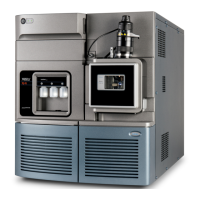
Do you have a question about the Waters Xevo TQ-XS Mass and is the answer not in the manual?
| Type | Triple Quadrupole Mass Spectrometer |
|---|---|
| Polarity | Positive and Negative |
| Polarity Switching Speed | 20 ms |
| Ionization Source | Electrospray Ionization (ESI), Atmospheric Pressure Chemical Ionization (APCI) |
| Mass Resolution | 0.7 FWHM |
| Operating Temperature | 15-30 °C |
| Operating Humidity | 20-80% (non-condensing) |
Provides contact details for Waters technical support and general inquiries.
Outlines potential hazards and precautions related to the mass spectrometer device.
Explains the IntelliStart technology for instrument performance monitoring and setup.
Details compatibility and configuration with ACQUITY UPLC/MS systems.
Describes various ionization techniques and optional source probes for the system.
Details the components and operation of the IntelliStart fluidics system.
Explains the functioning of the mass spectrometer's ion optics.
Lists and explains the different MS operating modes.
Lists and explains the different MS/MS operating modes available for analysis.
Details the connectors and controls located on the mass spectrometer's rear panel.
Steps for preparing the mass spectrometer before powering it on for operation.
Procedure for powering on and initializing the mass spectrometer and associated software.
Explains the meaning of the mass spectrometer's LED indicators for operational status.
Instructions for setting up and preparing the IntelliStart Fluidics system.
Instructions for safely shutting down the mass spectrometer in an emergency situation.
Overview of how to prepare the mass spectrometer for different operational modes.
Details on configuring and using ESI, ESCi, and APCI ionization modes.
Information on installing and operating the combined APPI/APCI source.
Instructions for installing and removing the UniSpray source.
Information on installing and using the NanoFlow ESI source for low flow rate analysis.
Describes the installation and use of the ionKey source for integrated UPLC separation.
Outlines periodic maintenance tasks to ensure optimal instrument performance.
Guidance on using Connections INSIGHT for proactive service and support.
General safety precautions and handling guidelines for maintenance procedures.
Procedure to follow before performing operations on or inside the instrument's source.
Steps for removing and fitting the source enclosure on the instrument.
Instructions on how to open and close the source isolation valve.
Guidance on cleaning various source components for optimal performance.
Instructions for removing, disassembling, cleaning, and assembling the sampling cone.
Steps for cleaning the ion block assembly components.
Steps for cleaning the StepWave ion guide assembly, including disassembly and reassembly.
Procedure for removing and installing the probe assembly.
Instructions for replacing the ESI probe tip and its associated gasket.
Procedure for removing and fitting the APCI probe heater.
Guidance on cleaning or replacing the corona pin for APCI and ESCi modes.
Steps for changing the UV lamp bulb in the APPI/APCI source.
Instructions for replacing the APPI lamp drive assembly O-rings.
Procedures for removing and installing fluidic lines for the ionKey source.
Steps for cleaning the ionKey source and its connectors.
Explains the meaning and application of various hazard and warning symbols.
General warnings applicable to all Waters instruments and devices.
Details the rear panel connections for external wiring and vacuum systems.
Instructions for installing and connecting the EBARA oil-free roughing pump.
Procedure for connecting the nitrogen gas supply to the instrument.
Steps for connecting the collision cell gas supply, including argon requirements.
Describes the input/output signal connectors on the mass spectrometer's rear panel.
Guidelines for connecting the instrument to the appropriate electricity source.
Lists components exposed to solvents and their materials.
Details common solvents used for preparing mobile phases for LC/MS.
Provides a diagram of the IntelliStart Fluidics system plumbing.
Illustrates the plumbing connections for ionKey and TRIZAIC sources.
Lists specifications for replacement tubing used in the IntelliStart Fluidics system.